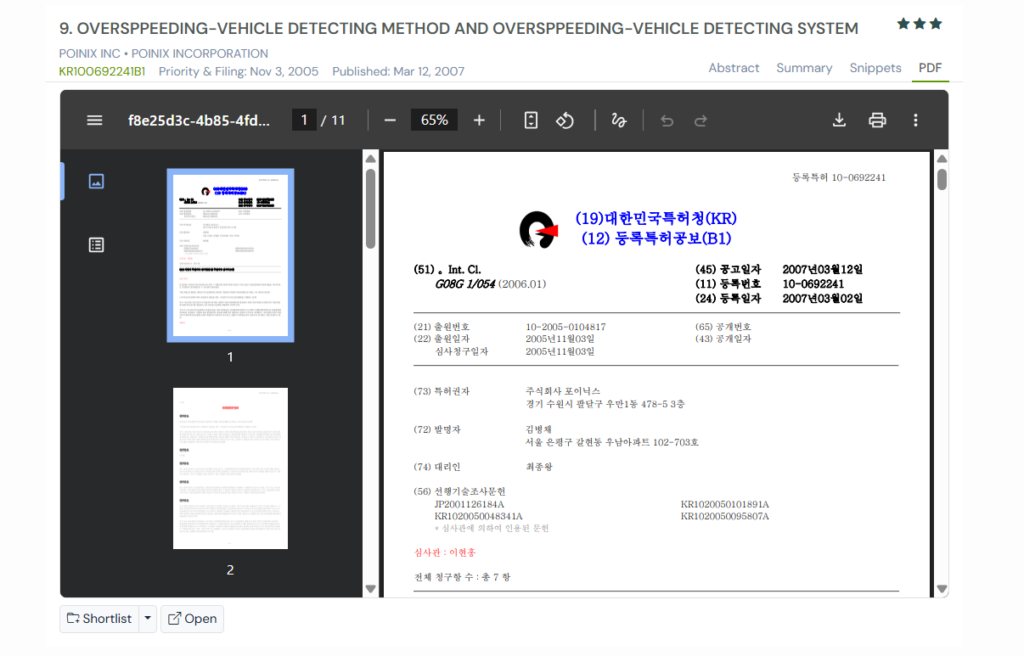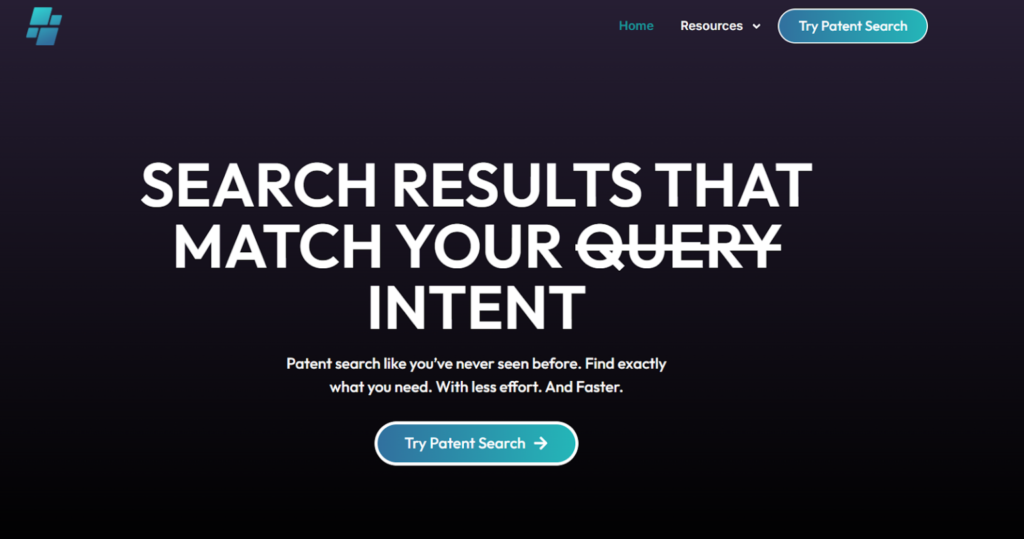You’re driving on an empty stretch of road, just a little over the speed limit. A flash goes off and before you reach your destination, a speeding notice lands in your inbox.
US9552724B2 is one of the patents that powers this process. By using cameras and AI to track vehicles, detect infractions, the invention describes how to deliver citations. Whether it’s a text alert for speeding or a formal notice for reckless driving, the system handles it all without human intervention.
It’s a step toward safer roads and smarter enforcement, where algorithms replace roadside stops and every violation is logged with precision.
To trace how this idea evolved, we used the Global Patent Search (GPS) tool. It revealed a network of patents shaping the future of intelligent traffic systems, turning simple cameras into digital enforcers of road safety.
Understanding How US9552724B2 Works
Let’s think of it like this. Instead of a single camera snapping a photo when you speed past, this system places multiple eyes along the road. Each one captures your car at different points, recognizes the license plate, and quietly calculates how fast you’ve been traveling between them. If that number crosses the limit, it doesn’t wait for an officer to pull you over. The system does the job itself.
But it’s not just about speeding. The same setup can spot weaving between lanes, ignoring stop signs, or even leaving an accident scene. And once it knows what happened, it decides how to act. It could be sending a quick digital alert for minor slips or a formal notice when things get serious.
In short, US9552724B2 takes traffic enforcement out of the patrol car and puts it into a smarter, safer network that never blinks.
Key Features of US9552724B2
What makes this patent stand out isn’t just the automation, it’s how intelligently every part of the process works together. From spotting a vehicle to delivering the right kind of citation, each feature adds a layer of precision and safety that traditional traffic systems simply couldn’t match.
Here’s how it all comes together:
1. Multi-point monitoring system: Instead of relying on one speed camera, the system uses several imaging points along a route. This helps calculate true travel speed between locations rather than a single-spot reading.
2. Smart image recognition: Each camera identifies vehicles automatically through license plate analysis, removing the need for manual checking or officer intervention.
3. AI-based violation detection: Beyond speeding, it recognizes patterns like unsafe lane changes, running stop signs, or hit-and-run behavior through real-time image analysis.
4. Automatic fault assessment: The system evaluates who’s at fault in multi-vehicle incidents, making enforcement fairer and more data-driven.
5. Adaptive citation delivery: Depending on the violation type, the system sends alerts differently like text messages for speeding, dashboard notifications for minor errors, and official notices for serious offenses.
Each of these features works like a cog in a larger machine, turning everyday traffic cameras into an intelligent enforcement network. Together, they make violations easier to detect, safer to manage, and faster to address.
A related direction appears in US7609961B2. The camera sits inside the vehicle’s light unit to preserve the exterior design and keep image capture accurate. It reflects a similar move toward integrated, unobtrusive monitoring seen in US9552724B2
Exploring the Web of Related Innovations in Smart Traffic Enforcement
Every breakthrough starts as one bright idea, then branches into many. The same goes for US9552724B2. Its concept of automated citation delivery didn’t appear in isolation.
It evolved from a series of earlier patents that explored how to track, assess, and communicate traffic behavior more intelligently.
To uncover those connections, we turned to the Global Patent Search tool. It helped trace a network of inventions that share the same goal: making traffic systems smarter, safer, and more autonomous.
1. KR20000052139A – The Unmanned Speed Monitoring System That Made Roads Smarter
Long before smart traffic cameras became common, KR20000052139A, filed in 1999 by Hwang Sun Wook, introduced a new way to monitor roads. It described a system that could work entirely on its own, without human supervision. Roads were divided into sections. Each section had a camera paired with a text recognizer to identify vehicle numbers.
As cars passed through these checkpoints, the system calculated how long they took to travel between two cameras. If a vehicle crossed the speed limit, it was photographed automatically, and a citation was printed. The setup could also spot lane violations, detect stolen vehicles, and measure overall traffic flow.

Both patents share the same foundation of multi-point tracking and automated image recognition. The difference is in how far the idea has evolved. The US patent adds AI-based judgment. It doesn’t just capture violations but also classifies them and decides how to send the citation.
Why This Patent Matters
KR20000052139A proved that road safety didn’t need to depend entirely on human enforcement. It turned cameras into smart observers that could calculate, analyze, and act on their own.
That early vision helped shape modern systems like US9552724B2, where automation doesn’t just record behavior but ensures accountability in real time.
US8319619B2 illustrates the same idea inside vehicles, using multiple fixed cameras to record every moment on the road. That shift toward uninterrupted visual monitoring aligns closely with the direction taken in US9552724B2.
2. US2011309950A1 – The Patent That Made Traffic Cameras Think
When traffic cameras first appeared, they were little more than silent witnesses. They could see, but not decide. That changed with US2011309950A1, filed in 2011 by Ariel Inventions LLC, which introduced a smarter way to detect and report speeding.
The system placed multiple cameras along a road and taught them to work together. Each captured vehicles at different points, identified them through image recognition, and compared timestamps to calculate travel speed.
If a car was moving too fast, the system didn’t wait for an officer to react. It automatically generated a citation signal, complete with the vehicle’s image, speed, and owner details.
The invention further linked these systems to onboard navigation and mobile communication channels, allowing drivers or law enforcement to receive alerts in real time. For the first time, a camera could not only detect a violation but also communicate it intelligently.
The patent sits right at the foundation of US9552724B2. Both share the concept of multi-point imaging and automated speed detection, but the later one evolves the process i.e. moving from simple detection to adaptive delivery.
Where US2011309950A1 could identify a speeding car, US9552724B2 could decide how to handle it based on the type of infraction and its severity.
Why It Matters
US2011309950A1 marked the shift from passive monitoring to active decision-making. It turned camera networks into intelligent agents capable of recognizing, analyzing, and acting without human input.
3. KR20000024551A – The Image-Recognition System That Helped Catch Speeders
At the turn of the millennium, South Korean inventor Kim Seong Ki filed KR20000024551A, a patent that brought image recognition into the world of traffic enforcement. Until then, most speed-tracking systems relied on sensors or radar guns. This invention changed that by teaching cameras to measure speed using nothing but images and timing.
Here’s how it worked: the road was divided into sections equipped with cameras and visual recognition devices. Each camera captured passing vehicles, recorded timestamps, and extracted license plate numbers.
The system then calculated average speed between two points to determine if the car was over the limit. What made it smarter was its connection to police databases. If the recognized plate matched a wanted or stolen vehicle, an alert was instantly sent to nearby police computers.

The idea overlaps directly with US9552724B2. Both systems rely on time-based image recognition to calculate vehicle speed.
However, while the Korean patent focused on detection and coordination with law enforcement, US9552724B2 expanded the scope i.e. not only identifying the violation but also deciding how to deliver the citation.
Why It Matters
KR20000024551A was one of the earliest steps toward intelligent traffic policing. It proved that cameras could do more than just record.
They could recognize, calculate, and communicate. By linking real-time data with police networks, it showed how technology could make enforcement faster and safer.
4. US6690294B1 – The Camera System That Took Over the Traffic Beat
In 2001, William E. Zierden filed US6690294B1, a patent that imagined a world where cameras could handle traffic enforcement on their own. His invention, known as the SPDCam, was designed to detect violations, capture high-quality images, and issue citations without a police officer ever stepping onto the road.
Each device used two cameras to photograph the vehicle and driver from different angles.
The images were tagged with GPS and time data, then sent to a central system that confirmed the violation and generated the citation automatically. It was faster, safer, and far more efficient than traditional radar-based policing.
The same idea evolved further in US9552724B2, which added intelligence to the process. Instead of only recording violations, the newer system could analyze the type of offense and decide how the citation should be delivered, creating a smarter and more adaptive approach to road safety.
Why It Matters
US6690294B1 showed that technology could take over routine enforcement without compromising accuracy or safety. It laid the groundwork for fully automated systems like US9552724B2, where cameras don’t just record what happens on the road but also understand how to respond.
5. KR100692241B1 – The Dual Camera System That Brought Precision to Speed Detection
In 2005, KR100692241B1 introduced an invention to improve the accuracy and reliability of speed enforcement. It tackled a long-standing problem that often occurred when regular cameras tried to calculate vehicle speed.
The system used two cameras positioned at fixed intervals along a road. Together, they captured a vehicle’s movement over a short period of time and calculated its speed with higher precision.
If a driver crossed the limit, the system automatically recorded the vehicle’s license plate, logged the time, and sent the information to a central control center. One of its strongest features was the ability to read reflective license plates at night by adjusting camera exposure and flash levels.

The patent shares its foundation with US9552724B2. Both rely on image-based monitoring and timing to track vehicles accurately. But KR100692241B1 focused mainly on perfecting the measurement, while US9552724B2 went further by adding smart decision-making to identify the type of violation and decide how the citation should be delivered.
Why It Matters
KR100692241B1 marked a turning point in how traffic cameras measured speed. It showed that precision and automation could work hand in hand, setting the stage for more intelligent systems like US9552724B2, where accuracy meets automation for safer, more efficient road monitoring.
Linking the Innovations Behind Smarter Road Policing
When viewed together, these patents tell a clear story about how automated traffic systems have evolved.
Each invention solved a specific challenge from early camera-based speed tracking to advanced image recognition and AI-powered decision-making.
The table below highlights how each related patent connects to US9552724B2, showing how their core ideas shaped today’s data-driven traffic enforcement systems.
| Patent | Core Focus | Overlap with US9552724B2 | Key Contribution to the Evolution of Smart Enforcement |
| KR20000052139A | Unmanned speed monitoring using sectional cameras and text recognition | Introduced multi-point tracking and automated image recognition | Proved that roads could be monitored without human intervention, paving the way for camera-based enforcement |
| US2011309950A1 | Multi-camera system for detecting and reporting speeding with real-time alerts | Shares the same base concept of coordinated imaging and automated citation generation | Marked the transition from passive monitoring to active, data-driven traffic management |
| KR20000024551A | Image recognition system to calculate vehicle speed and identify stolen cars | Both rely on image-based timing and recognition for speed validation | Demonstrated that cameras could calculate and communicate data, bridging detection and law enforcement |
| US6690294B1 | SPDCam system using digital imaging, GPS, and automation to issue citations | Uses image capture and GPS-based tracking similar to US9552724B2 | Showed that full enforcement could happen digitally, eliminating the need for manual policing |
| KR100692241B1 | Dual-camera system for high-precision speed measurement and night-time plate detection | Shares the principle of accuracy-focused multi-camera monitoring | Brought precision and adaptability, inspiring systems that blend accurate detection with intelligent decision-making |
Mapping the Future of Smarter Roads with GPS
Every patent tells a piece of the story behind how traffic systems became intelligent. But the bigger picture appears only when those ideas are connected.
That’s where the Global Patent Search tool proves invaluable. It helps uncover how one breakthrough in speed detection or image recognition influenced another, showing how today’s automated enforcement systems came to life.

Here’s how GPS helps you explore that journey:
- Start with one idea: Enter a patent number like US9552724B2 or describe a concept such as automated traffic citation system. GPS instantly finds related inventions, from early image-based speed detectors to AI-powered monitoring platforms.
- Follow the chain of progress: Each result shows short snippets revealing how earlier systems overlap with your present invention.
- See evolution in action: With a click, you can move through decades of innovation and understand how speed tracking, fault detection, and automated citation delivery gradually merged into one seamless process.
- Discover cross-industry links: You can also use the sort by relevance feature to further earlier surface patents of your interest. This might include advancements from imaging, data analytics, or even patents on smart mobility that shaped safer, more efficient road systems.
By connecting these insights, the Global Patent Search tool turns technical details into a clear timeline of innovation.
It helps engineers, policymakers, and researchers see how small ideas in automation have transformed into the intelligent traffic systems managing our roads today. If you want to get a peek into these patents too, try the tool today !
Disclaimer: The information provided in this article is for informational purposes only and should not be considered legal advice. The patent references mentioned are preliminary results from the Global Patent Search tool and do not guarantee legal significance. For a comprehensive related patent analysis, we recommend conducting a detailed search using GPS or consulting a patent attorney.
Frequently Asked Questions
1. Can AI really differentiate between different types of traffic violations?
Yes. With advanced image recognition, AI models can identify behaviors like lane weaving, red-light running, or tailgating by analyzing motion patterns and comparing them to predefined traffic rules.
2. Do these systems work at night or in poor weather?
Yes, they do. Infrared sensors, reflective plate recognition, and adaptive exposure settings allow cameras to capture clear images even in low light, fog, or rain.
3. How secure is the data collected by traffic enforcement cameras?
The data is typically encrypted and stored in centralized databases. There are strict protocols that regulate access to protect personal information and prevent misuse.




